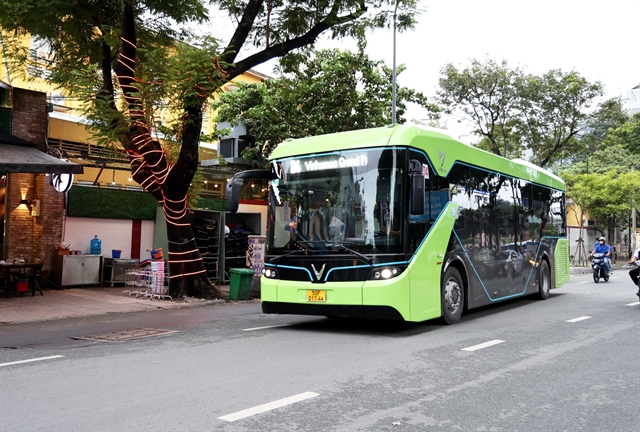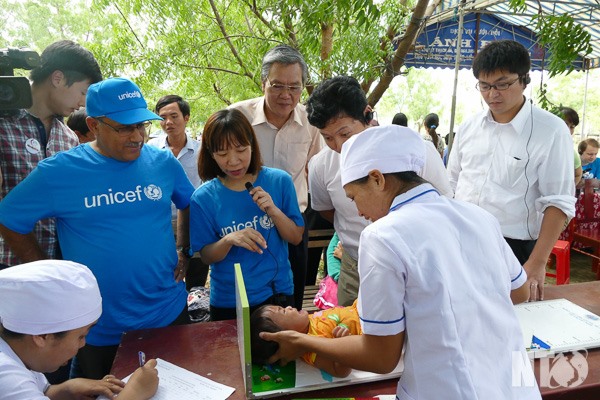 Environment
Environment

The increasing vulnerability of Vietnamese children to climate change and natural disasters will have long-term impacts on their wellbeing, experts warned at a conference yesterday
 |
| The increasing vulnerability of Vietnamese children to climate change and natural disasters will have long-term impacts on their wellbeing, experts warned at a conference yesterday. — Photo danviet.vn |
NINH THUẬN — The increasing vulnerability of Vietnamese children to climate change and natural disasters will have long-term impacts on their wellbeing, experts warned at a conference yesterday.
Speakers at the first-ever National Conference on Child-Centred Disaster Risk Reduction held in the coastal province of Ninh Thuận said the children’s nutrition, health and education would be affected.
The increasing frequency of climate change impacts, including natural disasters, calls for measures to protect and respond to the needs of children, they said.
Child-centred disaster risk reduction is a new approach that focuses on vulnerabilities rather than shock and stress.
It bridges humanitarian and development work by strengthening the resilience of children, families and communities before the crises through preparedness, disaster risk reduction and climate change adaptation.
The situation of natural disasters has become increasingly complex in Việt Nam, with new forms taking place on a large scale, causing great losses of lives, damaging infrastructure and hurting the economy.
Since the beginning of this year, it is estimated that 171 people have died and 30 people are missing due to natural disasters, inflicting economic losses of VNĐ37 trillion (US$1.65 billion).
“During the current floods in the central areas, 27 people were killed, including 10 children, from November 28 to December 12. Some of the children were killed on the way to school”, said Hoàng Văn Thắng, Deputy Minister of Agriculture and Rural Development.
“It is clear that women and children are most vulnerable to natural disasters and we need to implement further measures to reduce the impact of disasters on children,” he said.
“In hazard-prone areas, children pay a heavy price when these hazards materialise into disasters,” said Youssouf Abdel-Jelil, UNICEF representative in Việt Nam.
A significant part of Việt Nam was affected this year by the El Nino phenomenon, which left more than half a million children in need of humanitarian assistance.
Many of these children were already suffering from acute malnutrition, poor hygiene and sanitation conditions and a lack of care, he said.
Child-centred disaster risk reduction aims at strengthening accountability mechanisms between right holders – children and duty bearers – parents, communities, services providers and Governments, by improving information flows, enhancing transparency and developing capacities at various levels, he added.
Domestic and international experts also reviewed and drew lessons from recent responses to drought and salinisation to propose mechanisms and activities to actively and effectively respond and adapt to natural disasters.
They stressed the importance of sharing relevant knowledge and proposed orientations and co-operation frameworks for child-centred disaster risk reduction in Việt Nam.
Independent consultant Ian Wilderspin said child-centred disaster risk reduction and risk-informed programming would apply through the following measures: increasing capacity of institutions for disaster risk reduction, reducing child vulnerabilities, and strengthening disaster risk reduction capacities of children, families and communities.
Reducing child vulnerabilities would focus on integrated approaches to basic services such as health, nutrition, water and sanitation and education; on safeguarding child infrastructure such as schools, health clinics, housing and water and sanitation facilities; and social protection, he added.
As part of disaster risk reduction efforts, the Vietnamese Government and UNICEF have been providing critical support to children and women affected by the drought and saltwater intrusion crisis in ten provinces in the Central Highlands, South-central coast and the Mekong Delta, the conference heard.
Funded with $2.5 million in aid from the Government of Japan, it is estimated that the support has so far reached 140,000 vulnerable people in Việt Nam.
Conference participants agreed to develop a five year (2017-2021 with vision until 2030) Strategy and Programme on Child-Centred Disaster Risk Reduction.
The strategy will aim at strengthening the capacity of institutions as well as children, families and communities, increasing co-ordination between different sectors and stakeholders to reduce vulnerabilities of children. — VNS




